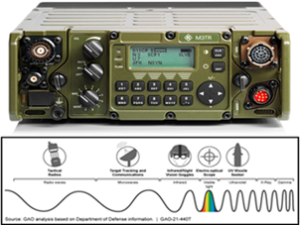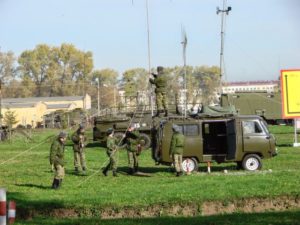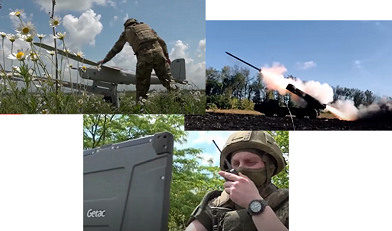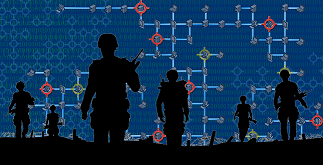“Instead of using those unique military frequencies and high-powered transmitters, you try to use signals that match what’s in the current environment.”
[Editor’s Note: Last week’s Mad Scientist Laboratory post featured an assessment by U.S. Army War College student LtCol Erik Keim (USMC) that “militaries will blend with civilian transmissions instead of relying solely on the specific military electromagnetic spectrum by 2030 due to the availability of Software Defined Radios (SDRs) and the proven success of digital camouflage.”
In today’s episode of The Convergence Podcast, Army Mad Scientist sits down with LtCol Keim to discuss the Future Dynamics of Warfare project he and his U.S. Army War College classmates collaborated on, his research on blending in the electromagnetic spectrum, and how the Army can adapt to the modern battlefield — Enjoy!]
[If the podcast dashboard above is not rendering correctly for you, please click here to listen to the podcast.]
LtCol Erik Keim  is currently a resident student at the U.S. Army War College. He holds a Bachelor’s Degree in Computer Science from the University of Wyoming and a Master’s Degree in Information Technology Management from the Naval Postgraduate School. He is the recipient of the 2015 Rear Admiral Grace Murray Hopper Award from the Naval Postgraduate School. LtCol Keim is a Marine Corps Communications Officer with over 20 years of service and deployments to Iraq, Afghanistan, and throughout the Western Pacific.
is currently a resident student at the U.S. Army War College. He holds a Bachelor’s Degree in Computer Science from the University of Wyoming and a Master’s Degree in Information Technology Management from the Naval Postgraduate School. He is the recipient of the 2015 Rear Admiral Grace Murray Hopper Award from the Naval Postgraduate School. LtCol Keim is a Marine Corps Communications Officer with over 20 years of service and deployments to Iraq, Afghanistan, and throughout the Western Pacific.
In our latest episode of The Convergence podcast, Army Mad Scientist sat down with LtCol Keim to talk about his work on the Team Sullivan’s Travels project at the U.S. Army War College, what his research showed for the U.S. Army, and how blending might be a viable course of action on a cluttered battlefield. The following bullet points highlight key takeaways from our conversation:
-
-
 Current military tactics use reserved frequencies and high-powered transmitters for communications. These actions stand out in the electromagnetic spectrum and make it easy for the enemy to triangulate and pinpoint the origin of the emissions for targeting and destruction.
Current military tactics use reserved frequencies and high-powered transmitters for communications. These actions stand out in the electromagnetic spectrum and make it easy for the enemy to triangulate and pinpoint the origin of the emissions for targeting and destruction.
-
-
-
-

Russia’s RP-377L (LORANDIT) Compact Multifunctional Radio Monitoring, Direction-Finding, and Jamming Complex facilitates the search of, position location, and jamming of VHF/UHF radio electronic communications. / Source: TRADOC G-2‘s OE Data Integration Network (ODIN) Worldwide Equipment Guide (WEG) The on-going war in Ukraine has shown that both sides are able to very quickly and easily identify and locate the source of communications transmissions and use a variety of kinetic attacks on those locations. Blending would be a viable alternative to using traditional military frequencies, with military communications “hiding within the noise” of commercial and civilian transmissions – e.g., WiFi, 4G and 5G, and Bluetooth.
-
-
-
-
 Blending in with the background electromagnetic spectrum “noise” makes it much harder for an adversary to detect and discern specific military communications from normal environmental transmissions. This may come with added risk — Russia, for instance, transitioned to using cell phone communications but used unencrypted signals that Ukraine was able to intercept and act on.
Blending in with the background electromagnetic spectrum “noise” makes it much harder for an adversary to detect and discern specific military communications from normal environmental transmissions. This may come with added risk — Russia, for instance, transitioned to using cell phone communications but used unencrypted signals that Ukraine was able to intercept and act on.
-
-
-
 The contemporary battlefield shows that if you are operating anywhere in the world, you can be seen, and if you can be seen you can be hit. Military operations require diligence when emitting and transmitting. Following the principles of shoot, move, communicate, and move again will help ensure survivability, but a mix of old and new techniques might be needed. Military software applications on cell phones that use cellular frequencies but protect transmissions may be key. High-fidelity decoys that can trick ISR systems might give forces just enough time to move before the enemy can discern what is real from battlefield deception.
The contemporary battlefield shows that if you are operating anywhere in the world, you can be seen, and if you can be seen you can be hit. Military operations require diligence when emitting and transmitting. Following the principles of shoot, move, communicate, and move again will help ensure survivability, but a mix of old and new techniques might be needed. Military software applications on cell phones that use cellular frequencies but protect transmissions may be key. High-fidelity decoys that can trick ISR systems might give forces just enough time to move before the enemy can discern what is real from battlefield deception.
-
-
-
- New or modified Military Occupational Specialties may be necessary as the role of Frequency Manager evolves. Instead of ensuring that forces have the requisite frequencies reserved for operations and working with host-nations to deconflict, they will instead need to become more proactively tactical — sensing the EM spectrum to understand what “normal” looks like, identifying anomalies
 that may indicate enemy operations, and knowing what ambient conditions are so that they can seamlessly blend in to hide their signals.
that may indicate enemy operations, and knowing what ambient conditions are so that they can seamlessly blend in to hide their signals.
- New or modified Military Occupational Specialties may be necessary as the role of Frequency Manager evolves. Instead of ensuring that forces have the requisite frequencies reserved for operations and working with host-nations to deconflict, they will instead need to become more proactively tactical — sensing the EM spectrum to understand what “normal” looks like, identifying anomalies
-

Stay tuned to the Mad Scientist Laboratory for our next episode of The Convergence on 20 June 2024, as we continue to explore the Future Dynamics of Warfare project with Army War College student LTC Kristine Hinds — addressing 5th Generation Warfare, the 6th Domain, and how we might need to adapt to defend ourselves and our Nation from these evolutions to the Operational Environment.
If you enjoyed today’s post, check out LtCol Erik Keim‘s Hiding in Plain Sight: Blending in the Electromagnetic Spectrum, as well as Team Sullivan’s Travels‘ Future Dynamics of Warfare: Everyone is a Player, Everything is a Target and their associated Final Report.
Review our series of blog posts exploring what we’re learning about the Operational Environment:
Unmanned Capabilities in Today’s Battlespace
The Operational Environment’s Increased Lethality
WMD Threat: Now and in the Future
The Hard Part of Fighting a War: Contested Logistics
Revolutionizing 21st Century Warfighting: UAVs and C-UAS
Explore the TRADOC G-2‘s Operational Environment Enterprise web page, brimming with information on the Operational Environment (OE) and how our adversaries fight, including:
Our China Landing Zone, full of information regarding our pacing challenge, including ATP 7-100.3, Chinese Tactics, BiteSize China weekly topics, People’s Liberation Army Ground Forces Quick Reference Guide, and our thirty-plus snapshots captured to date addressing what China is learning about the Operational Environment from Russia’s war against Ukraine (note that a DoD Common Access Card [CAC] is required to access this last link).
Our Russia Landing Zone, including the BiteSize Russia weekly topics. If you have a CAC, you’ll be especially interested in reviewing our weekly RUS-UKR Conflict Running Estimates and associated Narratives, capturing what we learned about the contemporary Russian way of war in Ukraine over the past two years and the ramifications for U.S. Army modernization across DOTMLPF-P.
Our Running Estimates SharePoint site (also requires a CAC to access), containing our monthly OE Running Estimates, associated Narratives, and the 2QFY24 OE Assessment TRADOC Information Paper (TIP).
Read the following related posts:
Insights from Ukraine on the Operational Environment and the Changing Character of Warfare
Pattern Detected! Masking by Injecting Randomness, by Chris Butler
Nowhere to Hide: Information Exploitation and Sanitization
War Laid Bare and Decision in the 21st Century, by Matthew Ader
Warfare in the Parallel Cambrian Age, by Chris O’Connor
Battlefield sensing and AI discussions in The Future of Ground Warfare and associated podcast, with proclaimed Mad Scientist COL Scott Shaw
Battlefield transparency and masking discussions in Top Attack: Lessons Learned from the Second Nagorno-Karabakh War and associated podcast, as well as Sooner Than We Think: Command Post Survivability and Future Threats and associated podcast, both with COL John Antal (USA-Ret.)
Disclaimer: The views expressed in this blog post do not necessarily reflect those of the U.S. Department of Defense, Department of the Army, Army Futures Command (AFC), or Training and Doctrine Command (TRADOC).



